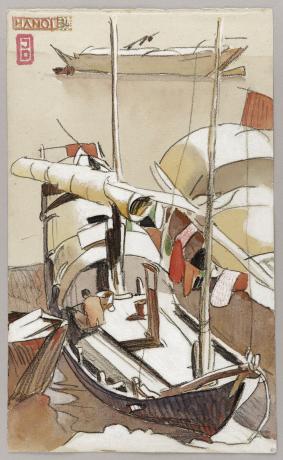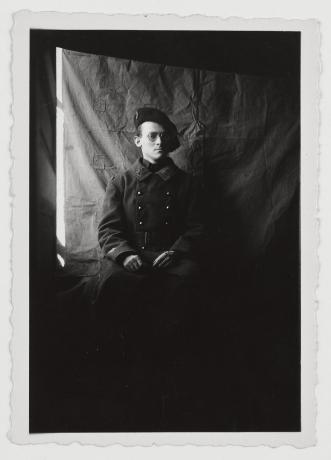Biography of Jean Delpech (1916-1988)
Jean Delpech started his training in Hanoi, where he was born and spent the first nineteen years of his life, before going on to receive rather more classical training at Paris’ School of Fine Arts. Draughtsman, engraver and sculptor, he also gained a reputation in the world of philately as the creator of several stamps. A unique artist, he saw himself as having much in common with the self-taught creators of “art brut”. He combines observation and imagination in works of extraordinary richness.
Training and youth
An Asian childhood
Jean Delpech was born on 1 May 1916 in Hanoi, then capital of French Indochina. He was Charles Delpech and Noémie de Boisseuil’s second child. Charles was a building designer in Hue, in Indochina. He rose through the ranks to become Indochina’s Architect of Public Works. Noémie had studied drawing and watercolour painting. Jean started drawing at a very early age, copying pictures he saw in magazines. “Ever since my childhood, I’ve drawn as I’ve breathed”, he said. His early drawings show his interest in local everyday life in Hanoi and testify to his curiosity, powers of observation and precocious talent.

Sampans à Hanoï, 1934. Coll. famille Delpech.
Photo © Paris - Musée de l'Armée, Dist. RMN-Grand Palais / Rachel Prat © ADAGP, Paris
“Aesthetic quality can’t be defined. It’s a feeling, yet at the same time it’s as simple as a mathematical formula. […] And anyway, art is everywhere.”
Jean Delpech quoted by Xavier Mervel in, « Les fantasmagories de Jean Delpech », Chasse-Marée, no. 154, 2002
After studying at Lycée Albert Sarraut, where Võ Nguyên Giáp was one of his classmates, Jean enrolled at Hanoi’s School of Fine Arts, opening himself up to a wide variety of artistic practices. In 1935, when he was 19 years old, Jean and his family returned to France.
First years in Paris and the impact of the War
“I’m not your average guy: “artist”, observer; here I am promoted to the corporal-pupil platoon. Carrying out interminable chores: roll-calls by barracks of 30, medical check-ups, distribution of uniforms, kitbags, odd-looking accessories, individual and collective weapons. We dress up as soldiers and take our civilian belongings to the ad hoc storehouse where they’ll wait two years for us to be set free again.”
Jean Delpech, War Diary

Anonyme, Jean Delpech en uniforme au 15e bataillon de chasseurs alpins, 1938-1939.
Coll. famille Delpech. Photo © Paris - Musée de l'Armée, Dist. RMN-Grand Palais / Rachel Prat © ADAGP, Paris
In 1938, he did his military service with the 15th Alpine Hunters Battalion (BCA), which was quartered in Barcelonnette.
When war brok out, he was mobilised, still with the 15th BCA, and sent to the front. He transcribed this dark period in a series of drawings and prints now in the Musée de l’Armée’s collection. During the German Occupation, he worked as an industrial drawing teacher at a technical school in Saint-Ouen and made use of his skills by forging false papers. At the end of the war, he exhibited his work in Paris for the first time, at the Christofle gallery, presenting a series of monotype prints created during the Liberation of Paris. He then asked to follow General de Lattre de Tassigny’s 1st Army as war correspondent for the periodical L’Armée Française au Combat, travelling to Alsace and then Germany. After the Armistice, he devoted a reportage to the bombed ports: Nantes, Saint Nazaire, Lorient, Brest and then Toulon.
An unclassifiable artist
In 1946, after the war has ended, he married Micheline, daughter of Robert Alphonse Collard, aka Lortac (1884-1973), a pioneer of animated cartoons; like him, she had been enrolled in Louis Roger’s studio at Paris’ School of Fine Arts.
A multi-talented artist
Once the war had come to an end, Delpech branched out in new artistic directions. In 1945, he created sets and costumes for King Lear, with Charles Dullin in the title role, and then tried his hand at illustration: Malraux’s The Conquerors (1947), Francis de Croisset’s The Wounded Dragon (1947). The same year, he was awarded the Blumenthal Prize for Engraving.
In 1948, he won the Rome Prize for Engraving and went on to spend three years in Rome, during which he documented popular life in highly detailed large-format compositions.
In the 1950s, he also created illustrations for Tamango and Federigo in Prosper Merimee’s Cinq Nouvelles (Five Novellas) (1952) as well as for Montesquieu’s Considerations on the Causes of the Greatness of the Romans and their Decline (1957), and provided several drawings for the covers of Gallimard’s science-fiction series “Le Rayon fantastique”.
In 1956, he was appointed Painter to the Navy and collaborated regularly with its magazine Cols Bleus. He made several journeys on board French Navy vessels, enabling him to combine his love of ships and the sea with his art. His sense of detail and skill in miniaturisation are also evident in his philatelic creations. As a stamp engraver, he provided several models for stamps issued by the Post Office, in the 1980s in particular. A tireless creator, he explored other artistic forms, including copperware, sculpture, and decoration, in the drawing Le Cerf Blanc (The White Deer) (1955), which served as a model for the mosaic in the church in Tréhorenteuc. He won the Jean Chièze Prize in 1979 for his woodcut Les Beaux Jours (Fine Days).
“I am constantly amazed by the variety and beauty of the world that chance has put me in. This endlessly renewed kaleidoscope never fails to cast its spell over me. My goal is to leave a testimony to our time.”
Jean Delpech
The role played by teaching
Jean Delpech started teaching during the war years. It was to remain a key activity throughout his career, at Rennes’ School of Fine Arts and at the City of Paris' evening classes in engraving held on the Boulevard du Montparnasse in the 1970s. He trained a whole generation of engravers, including Érik Desmazières, Yves Doaré, François Houtin, Étienne Lodého, Noël Marsault, Jean-Michel Mathieux-Marie, Philippe Mohlitz, Georges Rubel and Bertrand Seguy. He ended his teaching career at the École Polytechnique where, from 1974 to 1981, “he did his all to communicate knowledge and, perhaps still more a taste, an insatiable curiosity for multifaceted knowledge, through endlessly renewed techniques of expression.” (Claude Gondard, “20th Century”, SABIX Newsletter, no.47, 2010).
In 1983, he left Montrouge and settled in Sens, where he died in 1988.

Fievet, Jean Delpech dans son atelier, 1970, archives du musée de l’Armée.
Photo © Paris - Musée de l'Armée, Dist. RMN-Grand Palais / Rachel Prat © ADAGP, Paris
https://collectionjeandelpech.musee-armee.fr/en/biography-jean-delpech-1916-1988
